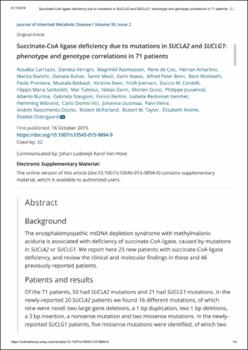| dc.description.abstract | BACKGROUND:
The encephalomyopathic mtDNA depletion syndrome with methylmalonic aciduria is associated with deficiency of succinate-CoA ligase, caused by mutations in SUCLA2 or SUCLG1. We report here 25 new patients with succinate-CoA ligase deficiency, and review the clinical and molecular findings in these and 46 previously reported patients.
PATIENTS AND RESULTS:
Of the 71 patients, 50 had SUCLA2 mutations and 21 had SUCLG1 mutations. In the newly-reported 20 SUCLA2 patients we found 16 different mutations, of which nine were novel: two large gene deletions, a 1 bp duplication, two 1 bp deletions, a 3 bp insertion, a nonsense mutation and two missense mutations. In the newly-reported SUCLG1 patients, five missense mutations were identified, of which two were novel. The median onset of symptoms was two months for patients with SUCLA2 mutations and at birth for SUCLG1 patients. Median survival was 20 years for SUCLA2 and 20 months for SUCLG1. Notable clinical differences between the two groups were hepatopathy, found in 38% of SUCLG1 cases but not in SUCLA2 cases, and hypertrophic cardiomyopathy which was not reported in SUCLA2 patients, but documented in 14% of cases with SUCLG1 mutations. Long survival, to age 20 years or older, was reported in 12% of SUCLA2 and in 10% of SUCLG1 patients. The most frequent abnormality on neuroimaging was basal ganglia involvement, found in 69% of SUCLA2 and 80% of SUCLG1 patients. Analysis of respiratory chain enzyme activities in muscle generally showed a combined deficiency of complexes I and IV, but normal histological and biochemical findings in muscle did not preclude a diagnosis of succinate-CoA ligase deficiency. In five patients, the urinary excretion of methylmalonic acid was only marginally elevated, whereas elevated plasma methylmalonic acid was consistently found.
CONCLUSIONS:
To our knowledge, this is the largest study of patients with SUCLA2 and SUCLG1 deficiency. The most important findings were a significantly longer survival in patients with SUCLA2 mutations compared to SUCLG1 mutations and a trend towards longer survival in patients with missense mutations compared to loss-of-function mutations. Hypertrophic cardiomyopathy and liver involvement was exclusively found in patients with SUCLG1 mutations, whereas epilepsy was much more frequent in patients with SUCLA2 mutations compared to patients with SUCLG1 mutations. The mutation analysis revealed a number of novel mutations, including a homozygous deletion of the entire SUCLA2 gene, and we found evidence of two founder mutations in the Scandinavian population, in addition to the known SUCLA2 founder mutation in the Faroe Islands. | en_US |


